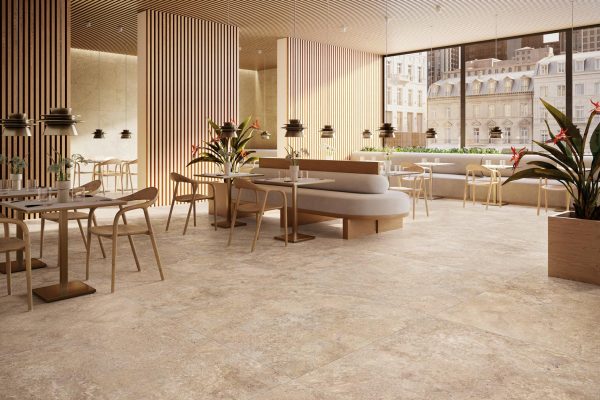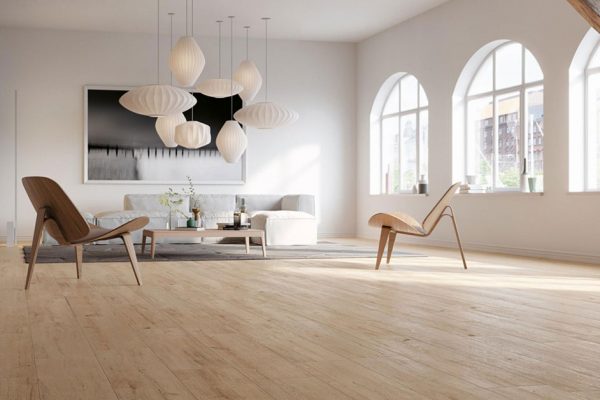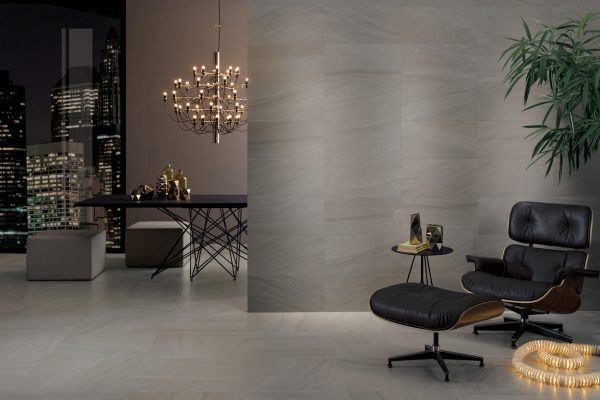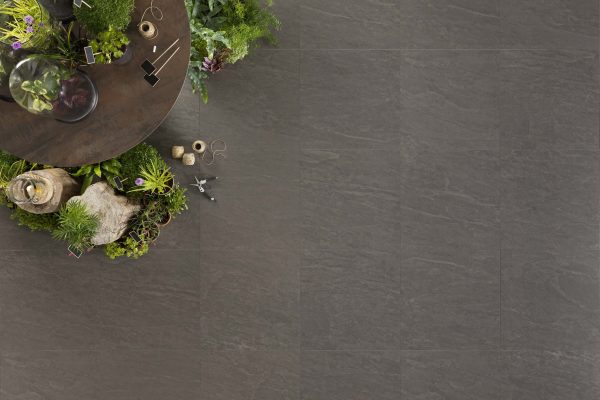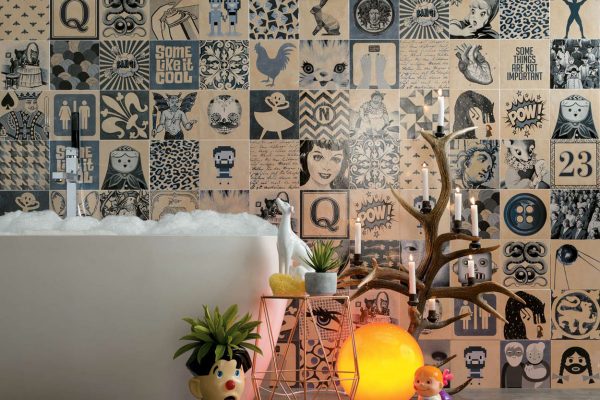To mark the occasion of Cersaie 2016, the International Fair Trade of Ceramics for Architecture and Bathroom Furnishing, Novoceram presents the Oz series, a range of stone-effect full-body colored tiles in porcelain stoneware, designed to use as floor or wall cladding indoors and outdoors.
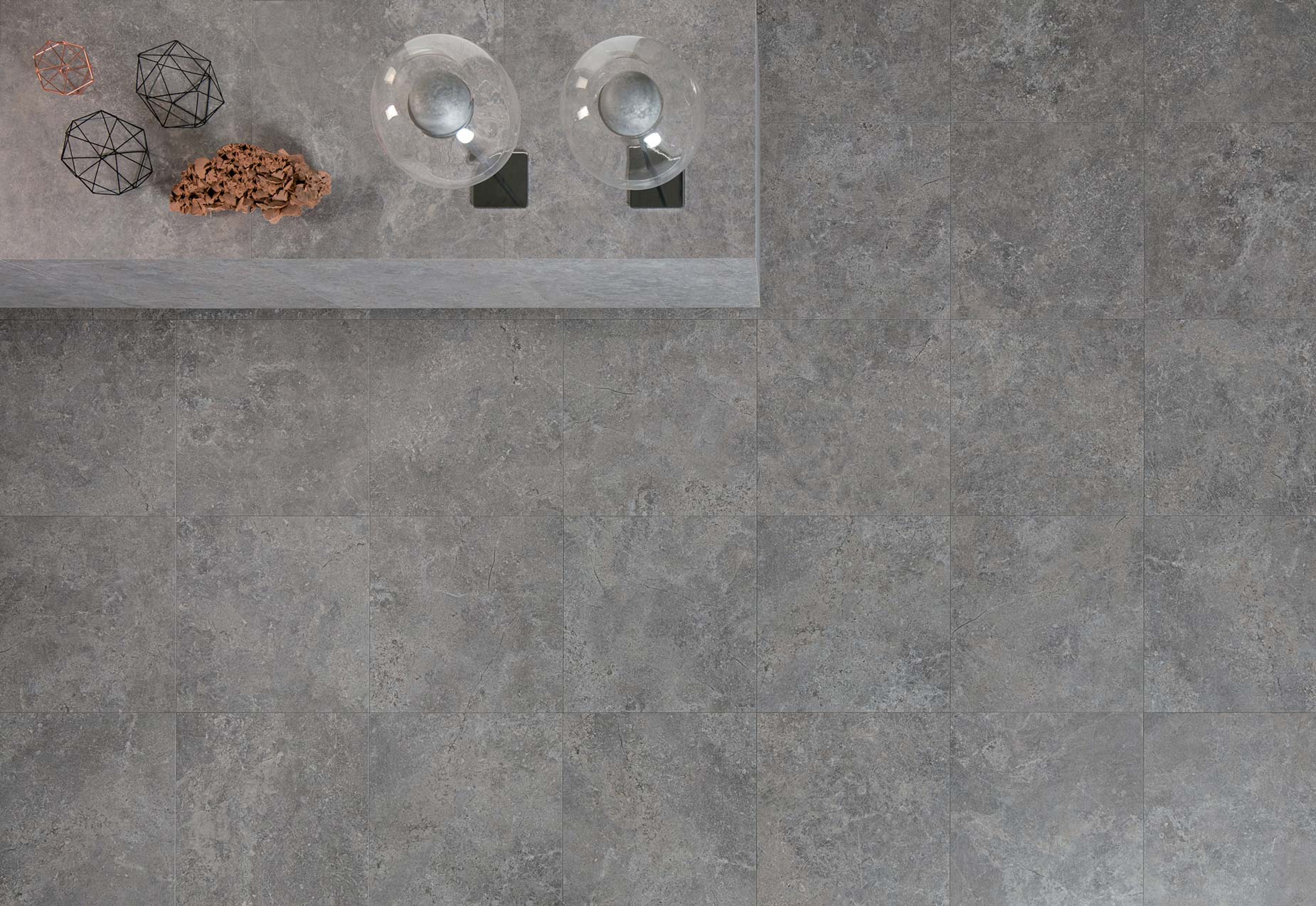
To better explain the peculiarities of this unique collection, we decided to interview Davide Possati, the product manager of Novoceram.
Oz is Novoceram’s flagship product for 2017. What sort of product is it?
Technically speaking, it is full-body colored porcelain stoneware, probably the most performing and versatile product of all the products used today for the cladding of floors and walls. It is a so-called “stone-effect” ceramic, even though at Novoceram we don’t really like the expression, as to talk about a simple “effect” sounds a bit too simplistic: on the one hand, the similarity with the natural stone is such that the installed tiles are virtually indistinguishable from the original material: not only are they aesthetically identical, but their feel to the touch and their reflection are the same; on the other hand, the ceramic material is far more resistant and practical in comparison to natural stone and is available in a number of colors and sizes that are unimaginable for the stone of inspiration. Besides, at least in the specific case of Oz, to obtain a supply of natural stone now would be extremely complicated…
Why is that?
The quarry has been closed: there are only two mined blocks of the stone remaining, and once they are gone, there will be no chance to getting the original stone ever again.
What kind of stone is it?
Oh, I can’t really reveal that! It is so rare to be able to discover a new material in this day and age that, when it does happen, it is inevitable that people keep it a closely guarded secret! However, from a geological point of view, it is a material result of the stratification of calcite, dolomite and quartz. These layers formed at the end of the Oligocene era, some 25 million years ago, when tuff (a type of volcanic rock) and lava of the area of origin – a volcanic area of central Germany, between Bavaria, Hesse and Thuringia – formed following a sedimentary sequence. It was used as a building material by the indigenous people back in the Bronze Age, and later by the Romans. Then forgotten, it was rediscovered in the 19th century, when the quarry was reopened once again, to be precise, in 1896. From that moment on it was rediscovered and used once again in modern architecture, thanks to its consistency and unusual and extraordinary color, which are absolutely unique due to the extremely high percentage of calcite and magnesium in the stone. As I said earlier, recently, following the closure of the quarry of extraction, it has become a very rare and exclusive material.
So where did you find it then!?
When we were developing the Cast series in 2011, a series inspired by the Vals stone, we found the stone of inspiration during a journey to Switzerland, undertaken specifically to research new stones to reinterpret using ceramic. I wish I could tell you a similar story in the case of Oz: at the end of the day, our job is like that of a writer who interprets and elaborates insights and information gathered through years of research… but that’s not the case here either. The truth is that we’ve had a piece of this stone in our laboratory for eight years! I can’t even remember how it got there… Piero Mesini, our research laboratory director, had made a ceramic version of that unique piece of stone a couple of years ago. When we decided to develop a collection, for 2017, in porcelain stoneware inspired by stone, we thought back to that piece and decided that the time was right to propose it again, along with other possible stone themes, at the first departmental meeting to define the new lines of research. The proposal was liked and we decided to produce it.
Once a theme has been decided, how does the industrial development process work?
Tortuously, at least in this case! That’s because we encounter problems right from the start: we only had that one single piece, the one recovered 8 years earlier. Luckily, we did remember where we found it. Then, after we had ordered a sufficient amount to discover the secrets of the stone’s graphics, we waited almost three months before it was delivered. But the biggest surprise was still to come…
What surprise was that?
The material delivered was nothing like the piece we had in our lab! Or rather: only about a quarter of the stones (an enormous amount of really heavy slabs measuring 40×40 cm with 4 cm thickness!) looked like the sample, but the rest was either much brighter or much darker, some were redder, others greyer, others more orange in a kaleidoscopic of color combinations, richness and designs! What I’m saying is this: something extraordinary in terms of richness of colors and depths of details – really, amazing, I had never seen anything like it before – and, trust me – we have seen so many things over the years! But it had nothing in common with what we had presented at the previous meeting when everyone had agreed it was a project worthy of development. It was an issue that needed to be address, especially as we had already spent three months and many thousands of euros on the purchase…
So, what did you do?
Let’s go back a minute to the initial question, the process of industrial development, we are in the habit of sharing information on every step of the product process with the heads of department involved in the final decision of new products. In essence, we invited them to take a look at the natural material, telling them in advance that what they were going to see would probably surprise them: it was a question of deciding whether it was a pleasant surprise or a negative surprise!
And today we can guess which way the decision went…
The final word on the matter was said by Danilo Comazzi, head of the sales department at Novoceram, who commented: “OK, let’s proceed as long as we make it look exactly the same as it looks now: don’t even change the tiniest of grains!” A challenge that did not turn out to be in the least bit easy! The stones were selected, pictures of them taken, a photo montage in the large formats they were intended to be sold in created and – above all – the process of conversion on ceramic format was begun, a process that involved hundreds and hundreds of tests on tiles to get the fine-tuning correct, the presentation of laboratory panels to discuss together any possible changes to be made and the constant repetition of the procedures over the following weeks, in a process of subsequent changes until a satisfactory result was reached. As well as that, of course, we had to select which “made-up” colors, those different from the natural stone, to use …
What colors are those, and in the case of Oz, how were they selected?
Along with the original color of the stone, called Original, Oz will be available in four other colors: Claire, Chaud, Gris and Foncé. To modify the color of such an extraordinary natural material as the stone of inspiration is a really tricky task: the result may look awkward and artificial. This is even truer for a stone such as this, which really does not look like any other stone. Nevertheless, as I was saying earlier, the natural stone has a mixture of layers of different colors that are markedly different from one another: therefore, the solution we found was that of developing each color in the range from each of the main color families of the stone. From the darkest Foncé, a warm dark grey; from the brightest Claire, a medium intensity ivory; from the intermediate Chaud, a grey beige that is difficult to define with precision, a color that is very much in line with the style of Novoceram! The slab of stone that had been lying in the laboratory for 8 years belonged precisely to this family of colors. And I haven’t even mentioned the fifth color, Gris: imagine that the original inspiration was taken from the thickness of the split stone, that takes on greyer and colder colors; we have made it even cooler to give the range a more balanced chromatic spectrum.
It is striking that of the five new collections that Novoceram will present at Cersaie 2016, three are inspired by natural stone: how did that decision come about?
The choice of the themes for the 2017 collection is the result of a decision making process that began way back in the autumn of 2015 and that involves various departments of the company, in particular Marketing, Sales and, of course, Management. In recent years, with new collections such as Ciment, Azimut, Zen, Vertige, Petitot, we have expanded the range of products inspired by materials such as cement, cotto and resins: we have clearly done a good job interpreting market demand, since they are series that have had tremendous commercial success. Even if there was the temptation to continue along the same path (and we weren’t running short of ideas!), we preferred to take on this new challenge, on one single theme – ceramic stone – that, in the target market of Novoceram (mainly France and French-speaking countries), turns out to be especially difficult and that – perhaps this is the reason why – is not often seen in our catalogue (of course, there are a few very good exceptions, such as Cast and Samsara, for example). We have chosen to take on the challenge in the way we always do, with originality and in a manner that is very attentive to the characteristics of the market: we hope we have succeeded and achieved both goals.
Would it be right to say that to a certain extent the development of a new collection of ceramic tiles is “design”?
Depending on the collection, the design content may be more or less evident, but each collection is conceived and designed with care through a long a process of research and development. For instance, the Azimut collection is a cotto-cement-effect collection declined into contemporary colors: we started from a very precise idea of what we were looking to achieve and gave specific indications to a craftsman (but maybe we should call him an artist) who created dozens of panels for us that were entirely hand-made with stuccos, colored terrae and varnishes and that we used as a starting base for the industrial elaboration of the project. In this case the process is the exact same as that of industrial design. Even the apparently slavish reproduction of a natural stone such as Oz, however, has a marked character of design and planning. First of all in the selection of the material: we discarded 70% of the natural stone at our disposal simply because we wanted to give Oz a certain well-defined character. Secondly, of course, in the development of the different colors of the collection: if Original is an exact reproduction of the color and color shading of the natural stone, the other four colors do not exist in nature, they have been entirely decided upon and determined by us, just as a fashion designer would do when choosing the color of the textiles for their collection.
Why the name Oz?
Not wanting in any way to use a name that could help identify the original stone, we were looking for a simple name, short and slightly magic, that could be pronounced the same way in the most widely spoken languages and that would be evocative for (almost) all of the people in the world. The aim is that of meeting the taste of different audiences, and to sell the product in as many countries as possible, and in the choice of the name, we have gone some way down the line of achieving that…
